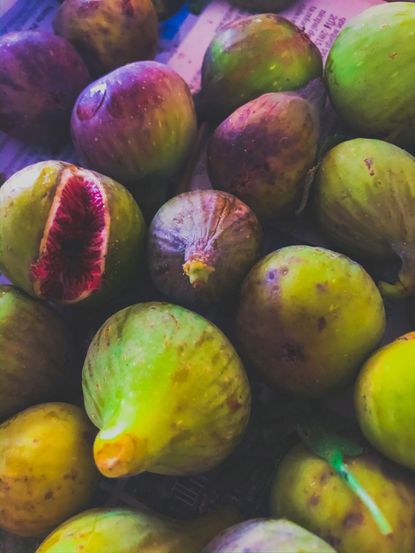Harvesting And Storing Fresh Figs - When And How To Harvest Figs

If you are lucky enough to have a fig tree in your landscape, you have access to some wonderfully sweet and nutritious fruit. Fig trees are beautiful, deciduous trees that can reach a mature height of up to 50 feet (15 m.), but typically between 10 and 20 feet (3-6 m.), making harvest fairly easy. Harvesting figs in the right manner and at the right time allows you to get the most from your tree.
When to Pick Figs
Wait until the figs are ripe to harvest. Figs will not continue to ripen after they are picked like many other fruits. You can tell that it is time for harvesting figs when the fruit necks wilt and the fruits hang down. If you pick a fig fruit too early, it will taste horrible; ripe fruit is sweet and delicious. As long as the fruit is still perpendicular to the stem, it is not ready to be picked. A perfectly ripe fig will also emit its nectar at its peak and be soft to touch. It is always better to error on the side of picking a fig that is slightly overripe than underripe. You can also watch for fruit color changes as the season progresses. The fruit will change as it gets riper. Each fig type has different colors and ripeness can vary from green to dark brown. Once you know what color your figs change to as they ripen, you will have a better idea of what to look for. Be sure to harvest in the morning on a partly cloudy day for the best results.
How to Harvest Figs
Figs are easy to harvest when they are ripe. One essential rule regarding fig tree harvesting is to handle the ripe fruit as little as possible to avoid bruising. Pull or cut the fruit gently from the stem, leaving some of the stem attached to the fig to help delay fruit spoilage. Place the figs in a shallow dish and do not pack them tightly on top of each other, as they bruise easily. Use caution when working above your head or on a ladder. If you have a tall tree, it's helpful to have an assistant while you pick. Note: Some people are allergic to fig latex, the milky, white sap that oozes from the leaves and branches and from the stems of unripe figs. The sap can cause itchy, painful dermatitis that can become worse when exposed to sunlight. If you are allergic to latex, be sure to wear long sleeves and gloves when harvesting figs.
Storing Fresh Figs
It is best to eat, use, dry, or freeze figs as soon as possible after harvest. If you dry the figs either in the sun or using a dehydrator, they will last for up to three years in the freezer. You can wash and dry the figs and place them on a baking sheet (not touching) and freeze until hard. Once the fruit is hard you can transfer them to a container and store them in the freezer for up to three years. Fresh figs will keep in the refrigerator when placed in a single layer on a tray. The tray should be placed in the coldest part of your refrigerator, usually the crisper. However, don't place the figs close to fresh vegetables, as they can cause the veggies to rot quickly. Eat figs stored in the refrigerator within three days.
Gardening tips, videos, info and more delivered right to your inbox!
Sign up for the Gardening Know How newsletter today and receive a free download of our most popular eBook "How to Grow Delicious Tomatoes."
-
 Urban Beekeeping Guide: Top Tips For Raising Bees In The City
Urban Beekeeping Guide: Top Tips For Raising Bees In The CityUrban beekeeping can be a rewarding and appreciated pastime, but first be sure it’s legal in your city and learn the ropes of beekeeping.
By Mary Ellen Ellis
-
 2024 Plant Of The Year: Why Experts Say Philodendron Is The “It” Plant Of The Year
2024 Plant Of The Year: Why Experts Say Philodendron Is The “It” Plant Of The YearWe aren’t surprised that philodendron was designated the plant of the year. Versatile, easy-care and lovely, it’s the houseplant of the year 2024!
By Bonnie L. Grant